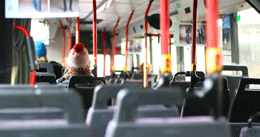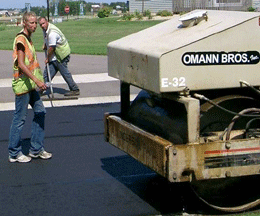Bus Pass or Bus Fail
Air Date: Week of June 26, 2009

Empty buses can be a major emitter of air pollution as well as energy hogs. (Photo: Andreas Solberg)
Sliding into a seat on the city bus, you may think you’re doing your part to save the environment. But UC-Berkeley researcher, Mikhail Chester, compared the energy and emissions of trains, buses, airplanes, and cars and found this is not always the case. He shares his surprising results with host Steve Curwood.
Transcript
CURWOOD: Sliding into a seat on a city bus, you may think you’re doing your part to save the environment. But a new study suggests that this is not always the case—riding public transit may not necessarily result in greater energy efficiency and cleaner air.
To evaluate the energy use and air pollution of various types of transportation more accurately, UC Berkeley researcher Mikhail Chester says that you need to take into account the entire life cycle, including infrastructure and maintenance.
Mikhail Chester is co-author of a recent study published in the journal Environmental Research Letters. The Berkleley team compared the energy and emissions of trains, buses, airplanes, and cars and found some unpredictable results.
CHESTER: One of the biggest surprises was not on the energy and CO2 side, but on the criteria pollutants side, sulfur dioxide, carbon monoxide, particulate matter, ground level ozone formation, you know, asthma rates in children, you know, these sort of things that contribute directly to human health impacts and environmental impacts. And the most surprising impact was that for a lot of these emissions, the bulk of them are not occurring at the vehicle’s tailpipe, but in these lifecycle components.
CURWOOD: So maybe not so much the car or bus, but the making of the road. Maybe not so much the train in operation, but the making of that train, the construction.
CHESTER: Absolutely. We’ve three million miles of roadways in the U.S. and what is the environmental impact of that – not just from an energy and CO2 perspective, but from these criteria pollutants I mentioned before. We’ve done a lot to sort of improve the tailpipe, what’s coming out of the tailpipe.
But when you don’t look at the tailpipe, when you look at all these lifecycle components you find that often they’re now the majority of the environmental burden. So, for roadways for example, there’s a lot of particulate matter released in the construction of roadways. When you construct a road you have to mine aggregate for the asphalt. You need to transport and process that material. You need energy to process that material and then you need to place the material. And all of these steps produce particulate matter along the way, and that turns out to be very large.CURWOOD: And the other major finding here is how much occupancy really affects things. So, if I look at your research carefully, seems to me that if I were driving a big honking SUV that say only got 12 miles to the gallon, but I took three other people with me, I’d be better off than driving a stingy say Honda hybrid that got 35 miles to the gallon just myself.
CHESTER: Right. And I think you should put that if in italics underline and bold, because that’s the important word there. But, yeah, that is correct. You know, this is – we should put it in context though. So SUVs are not being driven with three passengers in then. However, right – if you put three passengers in it and you compare it against a sedan with one passenger in it, it may be better off. I don’t think this is saying you should go out and buy SUVs, this is saying, you know, if you can get three passengers in it, that you’re better off than driving multiple sedans with one passenger in it.
CURWOOD: So, Mikhail, I’m looking at your study that you published and you have a really interesting set of charts in here, and one of them shows that an urban bus off-peak is probably the most energy intensive and greenhouse gas intensive way to go. It takes more than cars, even planes.

Empty buses can be a major emitter of air pollution as well as energy hogs. (Photo: Andreas Solberg )
CURWOOD: So, as a consumer, concerned consumer, worried about one’s energy footprint, seems to me that we should take solace when the bus is jammed. When you can’t get a seat, that’s a good thing for the environment.
CHESTER: I would think so, yeah.
CURWOOD: And likewise, if the plane is packed and you’re, you know, three or four of you to this row that was designed for children, again, this is more efficient.
CHESTER: Well, it is more energy efficient. Whether it’s comfortably efficient or ergonomic I don’t know.
[LAUGHING]
CURWOOD: Mikhail Chester is a researcher in the civil and environmental engineering department at UC Berkeley.
[MUSIC: Jenny Scheinman “Hard Sole Dance” from Crossing The Field (Koch Records 2008)]
CURWOOD: Coming up: today coal supplies half of the electricity in America– but unless we can give it a good and cost-effective cleaning, its future may not be burning bright.
It’s not just the problem of climate change that’s giving coal a black eye - new research has found that for residents in Appalachian mining country, the costs of the fuel far outweigh its benefits:
HENDRYX: One of the estimates translates into over 42 billion dollars, as the human cost of coal mining in Appalachia, some of the estimates are as high as over 80 billion dollars. The benefits of the coal economy measured by not just the direct jobs created but the indirect jobs that ripple through the economy as well as the severance taxes that are paid by coal companies, came to about 8 billion dollars a year.
CURWOOD: Counting up the true cost of the cheapest fuel. Keep listening to Living on Earth.
Links
Read more about the study on life cycle transportation emissions.
Living on Earth wants to hear from you!
Living on Earth
62 Calef Highway, Suite 212
Lee, NH 03861
Telephone: 617-287-4121
E-mail: comments@loe.org
Newsletter [Click here]
Donate to Living on Earth!
Living on Earth is an independent media program and relies entirely on contributions from listeners and institutions supporting public service. Please donate now to preserve an independent environmental voice.
NewsletterLiving on Earth offers a weekly delivery of the show's rundown to your mailbox. Sign up for our newsletter today!
 Sailors For The Sea: Be the change you want to sea.
Sailors For The Sea: Be the change you want to sea.
 The Grantham Foundation for the Protection of the Environment: Committed to protecting and improving the health of the global environment.
The Grantham Foundation for the Protection of the Environment: Committed to protecting and improving the health of the global environment.
 Contribute to Living on Earth and receive, as our gift to you, an archival print of one of Mark Seth Lender's extraordinary wildlife photographs. Follow the link to see Mark's current collection of photographs.
Contribute to Living on Earth and receive, as our gift to you, an archival print of one of Mark Seth Lender's extraordinary wildlife photographs. Follow the link to see Mark's current collection of photographs.
 Buy a signed copy of Mark Seth Lender's book Smeagull the Seagull & support Living on Earth
Buy a signed copy of Mark Seth Lender's book Smeagull the Seagull & support Living on Earth


